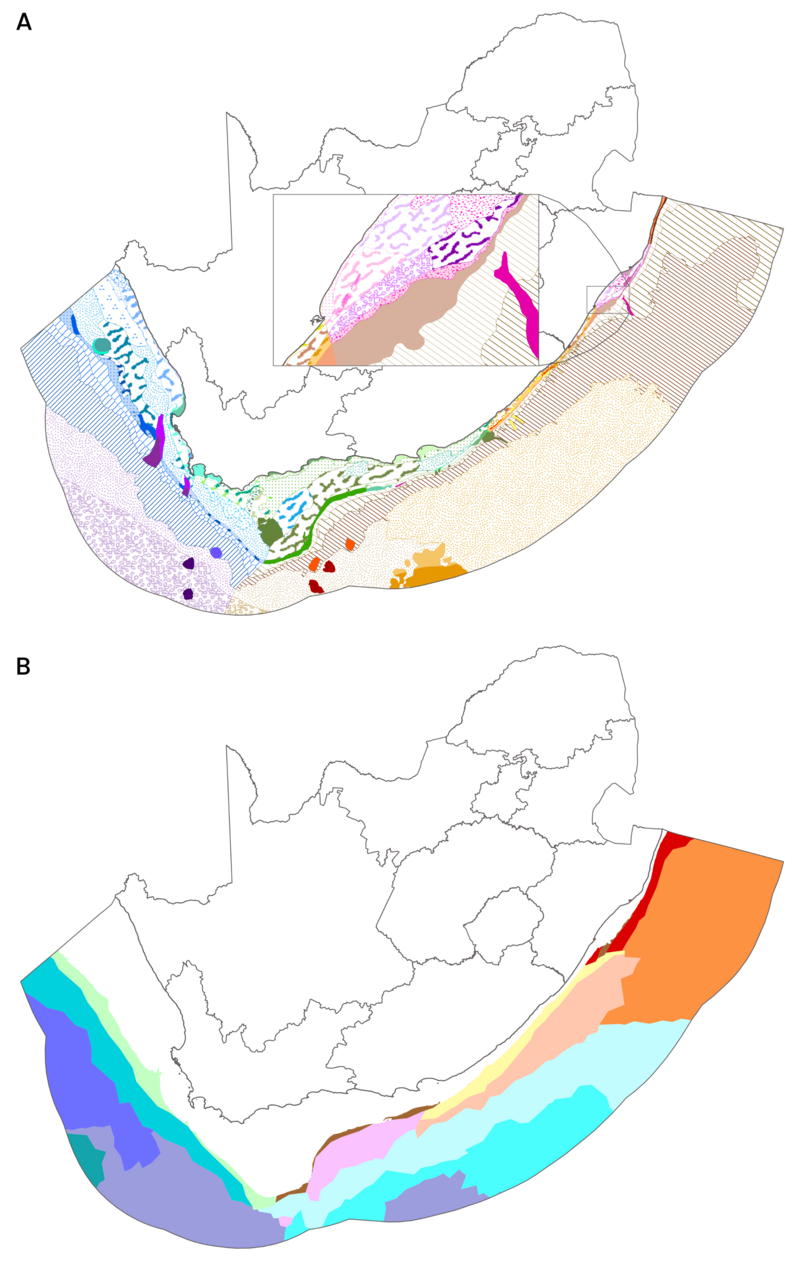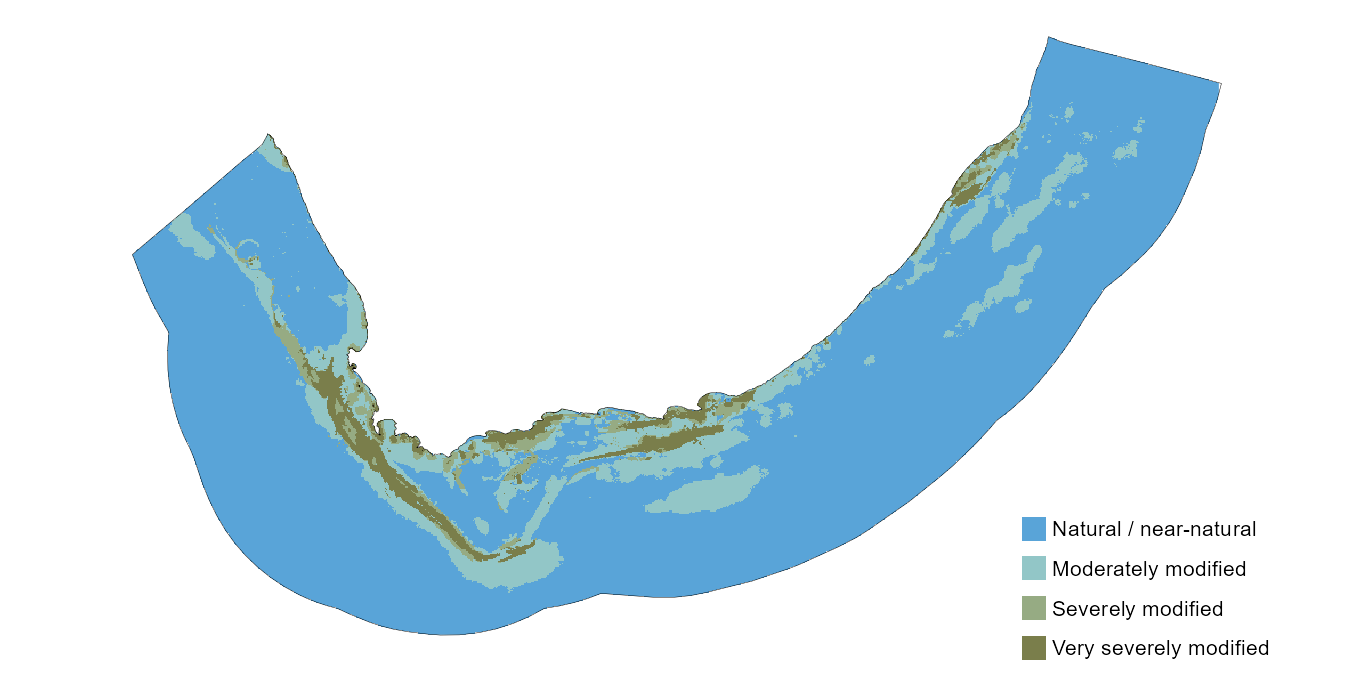
South Africa has exceptional marine biodiversity with 163 marine ecosystem types and high marine endemism linked to the intersection of three oceans and two contrasting current systems that interact with a diverse topographic and geological setting. Our marine biodiversity underpins food and job security, an expanding ocean economy, and contributes to deep cultural and spiritual values for South Africa’s oceans. The 2025 National Biodiversity Assessment identified marine ecosystems, species and benefits at risk, and co-developed priority actions to safeguard ocean life, livelihoods and maintain the many benefits of South Africa’s rich marine biodiversity.

of 163 ecosystem types
Threatened
of 163 ecosystem types
Well Protected
of 163 ecosystem types
Not protected
of 506 taxa assessed
Threatened
Ecosystem assessments
Of South Africa’s 163 marine ecosystem types, 45% are threatened, particularly smaller ecosystem types of restricted distribution. Several small, high-value ecosystem types are at risk of ecosystem collapse, which could compromise food, job and climate security (Key Message A2).
Overall, coastal and shelf ecosystems are at higher risk of ecosystem collapse, and the most threatened ecosystem functional groups are bays, deepwater biogenic beds, muddy shelves and rocky ecosystems on the shelf. Unless collaborative efforts are made to improve ecological condition in these functional groups, the vital ecosystem services and benefits they provide are at risk (Key Message A2).
More than 80% of South Africa’s 163 marine ecosystem types now have some representation in the Marine Protected Area (MPA) network, but only 20% are Well Protected (Key Message B4). Slopes, abyssal plains, muddy and rocky shelves, and open oceans are the most Poorly Protected ecosystem functional groups.
Increasing the extent of South Africa’s marine protected area estate will contribute to improving ecosystem protection levels. Importantly, however, the ecological condition of marine ecosystems in MPAs also needs improvement (Key Message C2) for ecosystem types to advance to Well Protected status. Ocean governance also needs to better consider and involve people in conservation initiatives (Key Message C1), diversify protection models, and address issues that undermine the legitimacy of conservation areas.
In the marine realm, 17% of ecosystem types are both highly threatened and under protected. These ecosystem types are found on the West Coast, the western Agulhas Bank shelf edge, parts of the Agulhas Bank and parts of the KwaZulu-Natal Bight (see intersection of marine threat status and protection level page).

Species assessments
Marine species are assessed in terms of their stock status and/or threat status. Stock status refers to the resource status from a fisheries management perspective, whereas species threat status focuses on extinction risk using the IUCN Red List of Threatened Species criteria.
There is increasing knowledge on stock status of resources, with evidence of resource recovery for some species linked to improved fisheries and spatial management (Key Message A5). This shows that fish stocks can recover with effective collaborative management of effort, catch and area. However, some inshore resources are increasingly depleted, and abalone and west coast rock lobster are Endangered. Illegal fishing plays a key role in the poor status of these species (Key Message A6).
Of the 506 marine species assessed using the IUCN Red List of Threatened Species criteria and thresholds, 36% are considered threatened (Key Message B1). However, this is an inflated estimate of the actual proportion of marine taxa that are threatened because species that are at risk and/or economically important have been prioritised for assessment, with few marine taxonomic groups being comprehensively assessed.

Sharks, rays and chimaeras are one of the most threatened groups across all realms. A re-assessment of South Africa’s seabreams showed improved threat status for three species while two have become more threatened. Of the 128 (may need update) South African shallow reef building corals assessed globally, 34% are threatened by climate change (Key Message A1).
Marine species continue to have the highest levels of data deficiency across all realms, signalling the need to address knowledge gaps, improve monitoring (Key Message C3), and increase capacity for marine species red listing (Key Message C3). High levels of data deficiency compromise effective species and ecosystem management, spatial planning, and decision-making.
Pressures and ecological condition
There are many interacting pressures cumulatively affecting marine ecosystems and species. Key pressures impacting marine biodiversity include fishing (including industrial, recreational and illegal fisheries), coastal development (including ports and harbours), pollution, shipping, mining, freshwater flow reduction, lethal shark control measures and climate change.
Fishing, petroleum activities and shipping are widespread sectors resulting in many pressures on multiple ecosystem components and species. Fishing, particularly industrial fishing, continues to exert the greatest pressures on marine biodiversity (Key Message A5) impacting ecosystems, species and genetic diversity (Key Message B3).
Hotspots of degradation and cumulative impacts are often driven by the location of ports and harbours, which increase access for fishing, alter shorelines and circulation, increase pollution, and facilitate the introduction and spread of invasive species. Pollution including industrial, municipal and noise pollution are key escalating pressures. Seismic surveys to detect potential offshore oil and gas resources have been expanding into deeper waters and, together with shipping and other sources of underwater noise, pose uncertain risks to marine ecosystems. Renewable energy production is important in achieving energy security and reducing climate change impacts but marine renewable energy development requires careful consideration of marine biodiversity impacts.
The first groundtruthing of marine ecosystem condition shows that pressure mapping is an effective proxy at broad national scales, but that finer scale pressure mapping can improve condition estimates. However, despite their importance in spatial planning, most marine pressure data are outdated, leading to missing pressures, poor resolution of some pressures, and inaccuracy of pressure impacts on ecosystem condition. Increased monitoring is needed to support assessment of ecosystem and species (Key Message B5), and to quantify ecological condition more accurately for both biodiversity assessment and guiding management.
The impacts of cumulative pressures also warrant consideration at multiple scales, particularly in evaluating the impacts of expanding and diversifying ocean economy activities. Failure to account for indirect and cumulative impacts will mean that important impacts are missed, resulting in poor spatial planning and decisions, with negative impacts on people and the environment (Key Message A2).
Priority actions and areas
Drawing from the key findings of this assessment, a number of priority actions were co-developed to improve the state of marine ecosystems and species. Science-policy workshops and other engagements were held to bring researchers, decision makers and knowledge holders together to consider evidence and make joint recommendations to address findings.
More than 70 individual actions were advanced (see priority actions), to improve the state of marine biodiversity in South Africa. These are being packaged into broad areas of action, with emerging indicators to support tracking of progress and outcomes.
Spatial biodiversity priority areas to protect, restore and recover marine ecosystems and species have been identified, and are being improved with increased participation, collaboration, and technical innovation.

Acknowledgements
[paragraph to be written by Megan]
Figure: construct logo cloud; see previous one and add: Wreckless Marine

